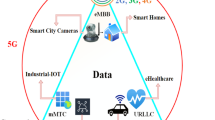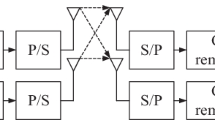Abstract
In this paper, a nonbinary (NB) LDPC-coded four-dimensional (4-D) rotated quadrature amplitude modulation (QAM) constellation scheme in Rayleigh fading channel is proposed. The optimal rotated angle of 16QAM constellation is obtained by exhaustive search. Compared with the conventional 16QAM constellation without rotation in Rayleigh fading channel, the proposed 4-D rotated 16QAM constellation scheme can obtain diversity gain. When spectral efficiency (SE) is 3.20 bits/s/Hz, compared with the regular 16QAM constellation system, the proposed 4-D rotated 16QAM constellation scheme can obtain 1.00 dB theoretical gain, while the simulated error performance gain of the proposed GF(256) LDPC-coded 4-D rotated 16QAM constellation scheme is 1.08 dB. When SE is 3.333 bits/s/Hz, compared with the regular 16QAM constellation system, the proposed 4-D rotated 16QAM constellation scheme can get 1.28 dB theoretical gain, while the simulated error performance gain of the proposed GF(256) LDPC-coded 4-D rotated 16QAM constellation scheme is 1.28 dB. Both the theoretical average mutual information analysis and simulated error performance show that the proposed scheme is efficient and reliable, which is suitable for the future ultra-high-reliable communications.





Similar content being viewed by others
Data availability
The data used or analysed during the current study are available from the corresponding author on reasonable request.
References
Popovski, P., et al.: A perspective on time toward wireless 6G. Proc. IEEE 110(8), 1116–1146 (2022)
You, L., Xiong, J., Ng, D.W.K., Yuen, C., Wang, W., Gao, X.: Energy efficiency and spectral efficiency tradeoff in RIS-aided multiuser MIMO uplink transmission. IEEE Trans. Signal Process. 69, 1407–1421 (2021)
Chen, S., Liang, Y., Sun, S., Kang, S., Cheng, W., Peng, M.: Vision, requirements, and technology trend of 6G: how to tackle the challenges of system coverage, capacity, user data-rate and movement speed. IEEE Wirel. Commun. 27(2), 218–228 (2020)
Forney, G., Gallager, R., Lang, G., Longstaff, F., Qureshi, S.: Efficient modulation for band-limited channels. IEEE J. Sel. Areas Commun. 2(5), 632–647 (1984)
Boutros, J., Viterbo, E.: Signal space diversity: a power- and bandwidth-efficient diversity technique for the Rayleigh fading channel. IEEE Trans. Inf. Theory 44(4), 1453–1467 (1998)
Herath, S.P., Tran, N.H., Le-Ngoc, T.: Rotated multi-D constellations in Rayleigh fading: mutual information improvement and pragmatic approach for near-capacity performance in high-rate regions. IEEE Trans. Commun. 60(12), 3694–3704 (2012)
Barrueco, J., Montalban, J., Iradier, E., Angueira, P.: Constellation design for future communication systems: a comprehensive survey. IEEE Access 9, 89778–89797 (2021)
Yao, Y., Xiao, K., Xia, B., Gu, Q.: Design and analysis of rotated-QAM based probabilistic shaping scheme for Rayleigh fading channels. IEEE Trans. Wirel. Commun. 19(5), 3047–3063 (2020)
Rebhi, M., Hassan, K., Raoof, K., Chargé, P.: Sparse code multiple access: potentials and challenges. IEEE Open J. Commun. Soc. 2, 1205–1238 (2021)
Davey, M.C., MacKay, D.: Low-density parity check codes over GF(q). IEEE Commun. Lett. 2(6), 165–167 (1998)
Voicila, A., Declercq, D., Verdier, F., Fossorier, M., Urard, P.: Low-complexity decoding for non-binary LDPC codes in high order fields. IEEE Trans. Commun. 58(5), 1365–1375 (2010)
Chen, P., Shi, L., Liew, S.C., Fang, Y., Cai, K.: Channel decoding for nonbinary physical-layer network coding in two-way relay systems. IEEE Trans. Veh. Technol. 68(1), 628–640 (2019)
Chen, P., Shi, L., Fang, Y., Lau, F.C.M., Cheng, J.: Rate-diverse multiple access over Gaussian channels. IEEE Trans. Wirel. Commun. 22(8), 5399–5413 (2023)
Xie, Q., Song, J., Peng, K., Yang, F., Wang, Z.: Coded modulation with signal space diversity. IEEE Trans. Wirel. Commun. 10(2), 660–669 (2011)
Caire, G., Taricco, G., Biglieri, E.: Bit-interleaved coded modulation. IEEE Trans. Inf. Theory 44(3), 927–946 (1998)
Funding
This work was supported by Fundamental Research Program of Shanxi Province (202203021212159, 20210302123208).
Author information
Authors and Affiliations
Contributions
Weimin Kang wrote the main manuscript and prepared all the work and reviewed the manuscript.
Corresponding author
Ethics declarations
Conflict of interest
On behalf of all authors, the corresponding author states that there is no conflict of interest.
Ethical approval
Not applicable.
Additional information
Publisher's Note
Springer Nature remains neutral with regard to jurisdictional claims in published maps and institutional affiliations.
Rights and permissions
Springer Nature or its licensor (e.g. a society or other partner) holds exclusive rights to this article under a publishing agreement with the author(s) or other rightsholder(s); author self-archiving of the accepted manuscript version of this article is solely governed by the terms of such publishing agreement and applicable law.
About this article
Cite this article
Kang, W. A nonbinary LDPC-coded four-dimensional rotated QAM constellation scheme in Rayleigh fading channel. SIViP 18, 2059–2063 (2024). https://doi.org/10.1007/s11760-023-02841-3
Received:
Revised:
Accepted:
Published:
Issue Date:
DOI: https://doi.org/10.1007/s11760-023-02841-3




